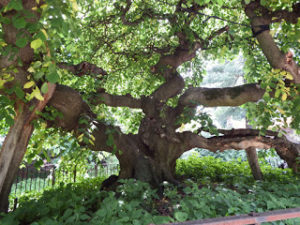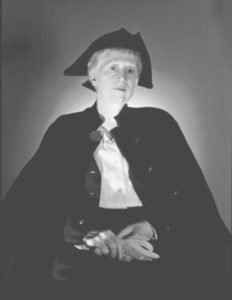A series of informal, intimate talks given by literary and cultural luminaries, In Conversation with the Rosenbach delves into fascinating histories, intellectual curiosities, and inspiring ideas. Each program offers the audience a chance to join the conversation after the talk and share their own thoughts and questions. Join us January 26 to hear Hyperallergic writer Allison C. Meier recount the surprising story of a neighborhood movement to save the Camperdown elm in Brooklyn’s Prospect Park–headed by poet Marianne Moore.

Rosen-blog: How did you first come across the story of Marianne Moore and the Camperdown Elm?
Allison C. Meier: When I first moved to New York in 2009, I was short on money, so I spent a lot of time just walking the city to explore. Prospect Park is vast, over 500 acres, but there was one tree that caught my eye: this strangely contorted Camperdown Elm. And on its protective fence is a plaque from the NYC Parks about Marianne Moore and how her efforts helped save it in the 1960s. Later, I had the chance to research the story while writing about local history for Brooklyn Based.

RB: Marianne Moore concludes her poem about the Camperdown Elm with the words “We must save it. It is/ our crowning curio.” From what you’ve read about the movement to preserve the tree and park, could you elaborate on what she might have meant by that?
ACM: Moore always loved the most curious examples of nature for visuals in her poems, whether the pangolin, jerboa, or octopus. She rarely used, say, a squirrel or something more familiar. The Camperdown Elm, being a rare grafted specimen from the 19th century, is certainly one of Brooklyn’s “crowning” natural oddities. I think its age, and striking appearance in a park that was then in rather bad shape preservation wise, was something that she thought deserved attention.
RB: You occasionally give cemetery tours in New York. Any good stories about writers or artists buried there?
ACM: There are so many, it’s hard to narrow it down. I think what’s most interesting is that often the artist’s grave is very humble in comparison to their legacy. For instance, Piet Mondrian is buried below a small granite monument in Cypress Hills Cemetery in Brooklyn, that is much less trafficked than his “Broadway Boogie Woogie” painting in MoMA. Robert Mapplethorpe’s photography is wildly popular now, yet his grave in Saint John Cemetery in Queens is barely known. Likewise, Thomas Crawford, who sculpted the 19.5-foot-tall “Freedom” statue on the dome of the United States Capitol, doesn’t have a marker at all in Brooklyn’s Green-Wood Cemetery. However, there is growing attention to these artists’ graves, and Green-Wood is planning to honor Crawford with one of his own marble sculptures. Something that is important to me in giving these tours is just remembering these people as people, and considering this final resting place in their legacy.
RB: You’ve carved such a fascinating niche for yourself as a history writer and cemetery tour guide. Did you ever consider other careers?
ACM: I’ve actually had quite a few careers! My first job out of college was as a development coordinator in an Oklahoma City art gallery, then I taught English as a language assistant in France. I temped all over when I first arrived in New York, until I landed a job in higher education communications. That I’m able to support myself with my passions is actually a rather recent thing, and I’m proud that I was able to stick with it over the years and find this niche. Who knows, maybe this isn’t my last career, there is so much to explore.
RB: What is your favorite book or object in the Rosenbach collection?
ACM: Definitely Marianne Moore’s tricorne hat!

